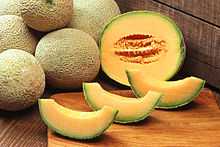Cantaloupe
| ||||||||||||||||||||||||||||||||||
Cantaloupe (also canteloupe, cantaloup, muskmelon (India), mushmelon, muskmelon, rockmelon, sweet melon, Persian melon, spanspek (South Africa), or Garma گرما) refers to a variety of Cucumis melo, a species in the family Cucurbitaceae. Cantaloupes range in size from 500 g to 5 kg (1 to 10 lb). Originally, cantaloupe referred only to the non-netted, orange-fleshed melons of Europe. However, in more recent usage, it has come to mean any orange-fleshed melon (C. melo). Cantaloupe is the most popular variety of melon in the United States.[2]
Etymology
The name is derived, via French, from the Italian Cantalupo which was formerly a papal county seat near Rome. Tradition has it that this is where it was first cultivated in Europe, on its introduction from Ancient Armenia.[3] Its first known usage in English dates from 1739 in The Gardeners Dictionary Vol. II by Scottish botanist Philip Miller (1691–1771).[3]
Origin
The cantaloupe originated in Iran, India and Africa;[4] it was first cultivated in Iran some 5000 years ago and in Greece and Egypt some 4000 years ago.[5]
Cantaloupes by region

The European cantaloupe is lightly ribbed (sutured), with a gray-green skin that looks quite different from that of the North American cantaloupe.[6]
The North American cantaloupe, common in the United States, Mexico, and in some parts of Canada, is actually a muskmelon, a different variety of Cucumis melo, and has a net-like (or reticulated) skin covering. It is a round melon with firm, orange, moderately sweet flesh and a thin, reticulated, light-brown rind.[6] Varieties with redder and yellower flesh exist, but are not common in the U.S. market. [citation needed]
Production and uses


Because they are descended from tropical plants and tend to require warm temperatures throughout a relatively long growing period, cantaloupes grown in temperate climates are frequently started indoors for 14 days or longer before being transplanted outdoors.
Cantaloupes are often picked, and shipped, before fully ripening. Postharvest practices include treatment with a sodium hypochlorite or bleach wash to prevent mold and Salmonella growth. This treatment, because it can mask the melon's musky aroma, can make it difficult for the purchaser to judge the relative quality of different cantaloupes.
Cantaloupe is normally eaten as a fresh fruit, as a salad, or as a dessert with ice cream or custard. Melon pieces wrapped in prosciutto are a familiar antipasto.
Because the surface of a cantaloupe can contain harmful bacteria—in particular, Salmonella [7]—it is always a good idea to wash and scrub a melon thoroughly before cutting and consumption. The fruit should be refrigerated for less than three days after cutting to prevent risk of Salmonella or other bacterial pathogens.[8]
A mouldy cantaloupe in a Peoria, Illinois market in 1941 was found to contain the best and highest quality penicillin, after a worldwide search.[9]
 and its cross-section | |
| Nutritional value per 100 g (3.5 oz) | |
|---|---|
| Energy | 141 kJ (34 kcal) |
| Carbohydrates | 8.16 g |
| - Sugars | 7.86 g |
| - Dietary fiber | 0.9 g |
| Fat | 0.19 g |
| Protein | 0.84 g |
| Vitamin A equiv. | 169 μg (21%) |
| - beta-carotene | 2020 μg (19%) |
| - lutein and zeaxanthin | 26 μg |
| Thiamine (vit. B1) | 0.041 mg (4%) |
| Riboflavin (vit. B2) | 0.019 mg (2%) |
| Niacin (vit. B3) | 0.734 mg (5%) |
| Pantothenic acid (B5) | 0.105 mg (2%) |
| Vitamin B6 | 0.072 mg (6%) |
| Folate (vit. B9) | 21 μg (5%) |
| Choline | 7.6 mg (2%) |
| Vitamin C | 36.7 mg (44%) |
| Vitamin K | 2.5 μg (2%) |
| Calcium | 9 mg (1%) |
| Iron | 0.21 mg (2%) |
| Magnesium | 12 mg (3%) |
| Manganese | 0.41 mg (20%) |
| Phosphorus | 15 mg (2%) |
| Potassium | 267 mg (6%) |
| Sodium | 16 mg (1%) |
| Zinc | 0.18 mg (2%) |
| Link to USDA Database entry Percentages are roughly approximated using US recommendations for adults. Source: USDA Nutrient Database | |
Footnotes
- ↑ 1.0 1.1 "Taxon: Cucumis melo L. subsp. melo var. cantalupensis Naudin". Germplasm Resources Information Network (GRIN). United States Department of Agriculture, Agricultural Research Service, Beltsville Area. Retrieved 2010-12-09.
- ↑ "Cantaloupe". WHFoods. Retrieved 2012-08-13.
- ↑ 3.0 3.1 Oxford English Dictionary 2nd Ed. (1989)
- ↑ Ensminger: 159
- ↑ Andrews: 1956
- ↑ 6.0 6.1 "Sweet, colorful 'cantaloupe': low-cal, nutritious" (July 2003) Environmental Nutrition 26.7
- ↑ Australian Govt Health Warning, October 2006
- ↑ "Kentucky: Cabinet for Health and Family Services - Salmonella2012". Retrieved 2012-08-18. "In general, the FDA recommends thoroughly washing and scrubbing the rinds of all cantaloupes and melons prior to cutting and slicing, and to keep sliced melons refrigerated prior to eating."
- ↑ Mary Bellis, History of Penicillin - Alexander Fleming - John Sheehan - Andrew Moyer
See also
- G.W. Swink, inventor of the cantaloupe crate
References
- "Cucumis melo". Integrated Taxonomic Information System. Retrieved September 3, 2002.
- Ensminger, Audrey H (1995). The Concise Encyclopedia of Foods & Nutrition. CRC Press: ISBN 0-8493-4455-7.
- Melons and Watermelons in the Classical Era, Alfred C. Andrews, Osiris, Vol. 12, (1956), pp. 368–375
- Cantaloupe - Origin Global Oneness
External links
| Wikimedia Commons has media related to Cucumis melo cantaloupe group. |
- Nutritional and Historical Information
- MSNBC Article on Farming of Hybridization That Mentions Cantaloupes
- Sorting Cucumis names – Multilingual multiscript plant name database
- Growing cantaloupes in the home garden
- Cantaloupe: Safe methods to store, preserve and enjoy, from University of California Agricultural and Natural Resources
| |||||||||||||||||||||||||||||||||
